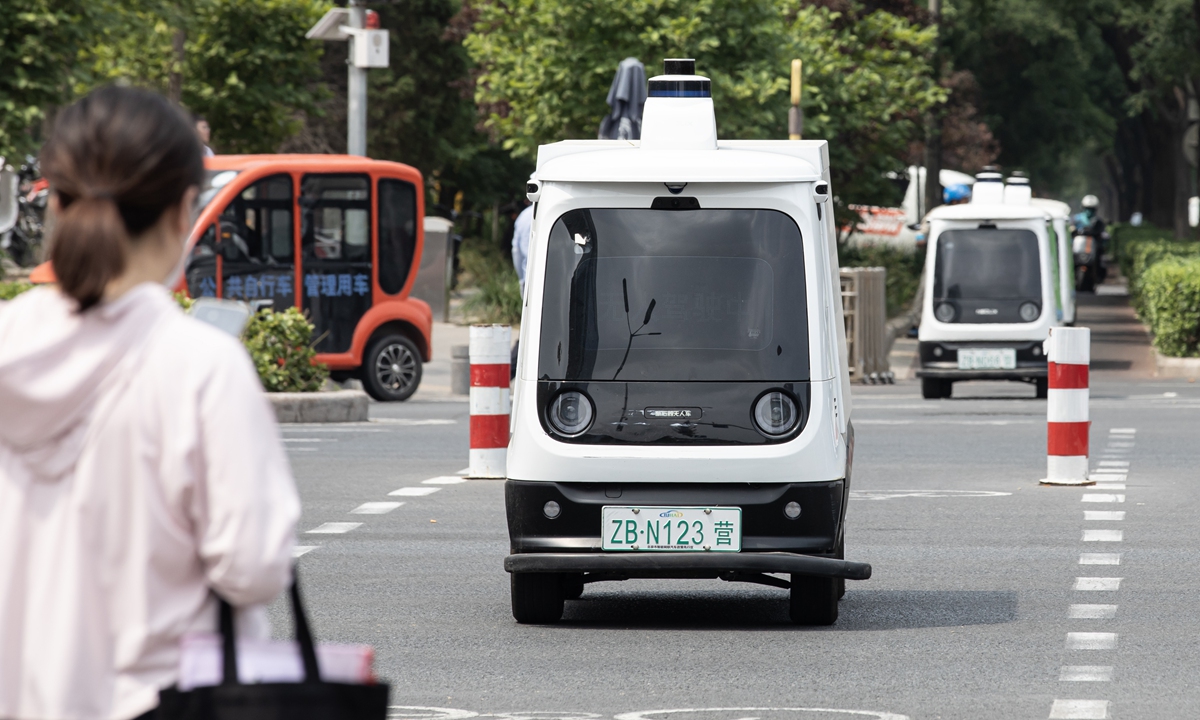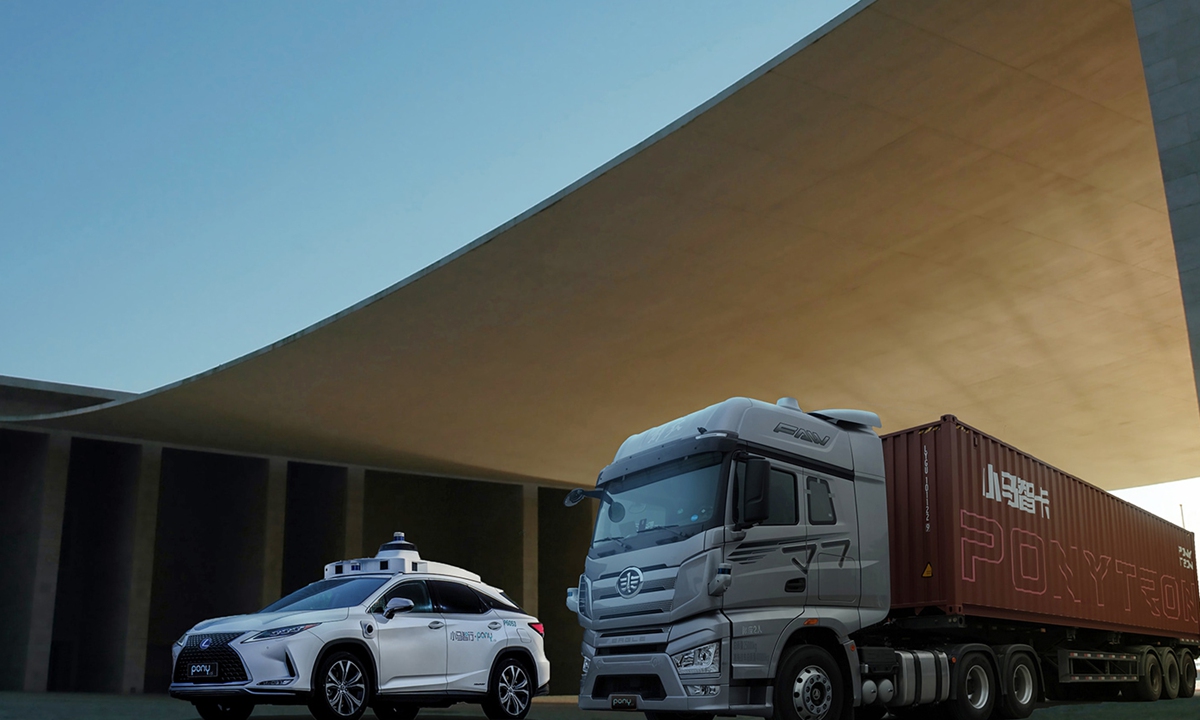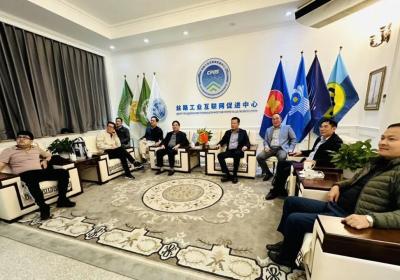A passenger gets off a self-driving vehicle.In Beijing Economic-Technological Development Area, also known as Beijing E-…

A passenger gets off a self-driving vehicle.
An unmanned delivery vehicle is seen on the street of Beijing E-Town. Pony.ai's self-driving vehicles
In Beijing Economic-Technological Development Area, also known as Beijing E-Town, drivers and pedestrians have started to get used to a new phenomenon: cars passing by without drivers, only passengers in.
Late at night, self-driving sanitation vehicles follow their routes, keeping the city clean; self-driving patrol vehicles precisely execute security tasks, ensuring residents' safety around the clock; self-driving buses shuttle back and forth along streets lined with flowering paulownia trees ... Scenes that were once only seen in science fiction movies are now a reality here.
Beijing initiated the autonomous driving demonstration area in September 2020, the first-ever integrated vehicle-road-cloud system across the globe. As technology and industry continue to develop, the latest and most advanced self-driving scenarios are taking root in E-Town, bringing autonomous driving into citizens' daily lives.
Learning from 'experienced drivers'
Every day during its commute, a car appears on time in front of Lou Tiancheng, co-founder and chief technology officer (CTO) of Pony.ai, an autonomous driving startup. The driver's seat is empty, with the steering wheel turning on its own, controlling the directions.
"If it's your first time, you might feel quite nervous," said Lou. After working in autonomous driving research for a long time, this way of travel has become a habit for him. However, he believes that once people try it a few times, any concerns about autonomous driving will be quickly dispelled.
Nowadays, you can experience this kind of service, robotaxi, through the Pony.ai app. Just on the streets of E-Town, Pony.ai has over 100 test vehicles driving around. Compared with traditional taxis, robotaxis have obvious advantages - precise route calculation eliminates detours and erratic driving, and the smooth driving experience, quiet cabins, and frequent disinfection provide passengers with a more comfortable travel experience. This service has already been launched in big Chinese cities of Beijing, Shanghai, Guangzhou, and Shenzhen.
What's more, the passenger space can also be transformed into a space for various functions like a meeting room or resting area, depending on the passenger's needs. Achieving this level of autonomous driving requires a complex learning process and the dedicated efforts of countless researchers.
For Zhang Ning, Vice President and Head of Pony.ai's Beijing Research Center, the company's autonomous vehicle often serves as his office for most of the day each week. Zhang orders multiple trips on his phone, letting the car roam around E-Town while he continuously contemplates on ways to improve the product through first-hand experience. Whenever he has the chance, Zhang walks down the streets, talking to different people to understand their needs and thoughts in various traffic environments as drivers, cyclists, and pedestrians.
The most important aspect is safety.
Autonomous driving did not start with complete-free human intervention. Lou recalled that even after receiving the test permit in 2018, there was still a safety driver in the main driver's seat for a long time, who then moved to the passenger seat before fully exiting the vehicle at the end of 2022. This progression happened after extensive testing proved that safety standards were met.
Long-term autonomous driving research has deepened Pony.ai's understanding of the technology. To make it safer, Lou said the company underwent a complex learning process, including studying the driving methods of many drivers. They found that experienced drivers commonly know how to reduce the difficulty for others on the road, he said. If your driving behavior is easily understood by other drivers, it reduces their chances of making mistakes. This is also a focus in their autonomous driving research - helping other drivers on the road to reduce errors, Lou added.
In addition, safety also comes from data accumulation. Since establishing its domestic research center in Beijing in 2017, Pony.ai has accumulated over 31 million kilometers of autonomous driving mileage, equivalent to the lifetime driving experience of dozens of ordinary drivers. Through repeated testing, the system's performance in safety, comfort, and efficiency has improved, which is a prerequisite for offering autonomous driving services to the public.
Lou said, "Autonomous vehicles are already some of the safest on the road, but we understand that the public has higher expectations for autonomous driving. We can always make it safer."
The vision for large-scale promotion of autonomous driving extends beyond whether humans control the steering wheel. Lou mentioned that the relationships between cars and people, and cars and roads, will change, potentially creating new needs for cars such as resting, working, and hosting guests. "Achieving safe autonomous driving is just the first step; there are many more things we can do afterward."
In fact, Pony.ai's exploration of autonomous driving is not limited to cars but also extends to trucks.
In 2022, the "Tianjin Port to Majuqiao Logistics Park Highway Freight Autonomous Driving Pilot" project was approved as the first cross-provincial highway autonomous freight testing project in China. The Beijing-Tianjin-Tanggu Expressway connects Beijing's logistics base at Majuqiao on the one end and Tianjin Port, the maritime gateway to the Beijing-Tianjin-Hebei region, on the other. Now, it's common to see white smart trucks driving smoothly along this highway according to predetermined routes.
Recently, this pilot project successfully passed an on-site verification of its results, with Pony.ai and other enterprises in E-Town helping the project pass the expert review smoothly. This is part of the Ministry of Transport's first batch of pilot intelligent transportation applications.
Additionally, Pony.ai is exploring autonomous truck logistics in multiple regions across China, capable of operating under various road types, weather conditions, and lighting scenarios. Currently, Pony.ai and its joint venture CYANTRON Logistics have achieved over 5 million kilometers of autonomous truck testing mileage, with a total freight weight of nearly 25 million ton-kilometers.

Developing 'new colleagues' for couriers
On the streets of E-Town, people gathered around a moving small car, observing it. Some took out their phones to record the car in motion, others touched it, and some posed for photos when it stopped at a red light.
For the staff behind the scenes at Neolix unmanned delivery vehicles, such scenes have become commonplace. On a large screen, the positions of each vehicle and real-time images from their cameras are displayed continuously. Selecting any vehicle shows the sunny streets of E-Town, with text indicating, "Unmanned vehicle X33952 is en route to the western gate of MCC (Metallurgical Corporation of China), covering a planned distance of 20.4 kilometers, and having traveled for 4 minutes and 49 seconds so far..."
At the entrance of Building 1, Yard 11, Kangsheng Industrial Park in Beijing E-Town, unmanned delivery vehicles line up one by one. Inside the white building, these small vehicles stop under a massive conveyor belt, automatically open their tops, and get loaded with goods from the second-floor conveyor belt before closing their tops and slowly driving out.
This is Neolix's shared distribution factory, where lights illuminate the unmanned delivery process for visitors. A large vision statement above the factory reads, "Let everyone enjoy the new digital logistics services brought by autonomous driving."
"In fact, we wouldn't need to turn on the lights if not for the demonstration. This is a smart logistics factory that can operate completely in the dark," said Neolix's founder and CEO Yu Enyuan.
The confidence to operate without lights comes from their self-developed system.
Relying on the intelligent dispatching of the backend system, the entire factory can accurately match hundreds of unmanned delivery vehicles with packages from various sorting channels.
On the large screen, the view of the unmanned delivery vehicle is displayed - everything nearby is composed of different-sized blocks. When the vehicle detects obstacles, it locks onto the target, calculates its size and range, and decides whether to proceed or detour. Whether it's rainy, nighttime, or complex road conditions, the unmanned delivery vehicle moves forward in this way.
Through the high-level autonomous driving demonstration zone's cloud control platform, these road conditions are transmitted back to the shared distribution center in real-time for management and monitoring. The continuously transmitted data become new samples for training model stability. As of April 24, Neolix's unmanned vehicles have safely traveled 7,139,062 kilometers nationwide.
Safety issues can be very specific. For example, night, rain, pedestrians, and bicycles are challenging scenarios for both humans and autonomous driving. Additionally, the frames of unmanned delivery vehicles are very thin to minimize collision risks for pedestrians. As Yu put it, "If our vehicle collides with a person, our principle is to ensure no harm to people, even if it means damaging the full truck of goods."
Yu mentioned that each small vehicle is equipped with an autonomous driving system. He pointed to a central integrated module hanging nearby, explaining that it integrates various functions such as computing power, communication, positioning, and sensors, including two lidar sensors, twelve cameras, and an automotive-grade computing platform. This system provides a 120-meter perception range and 360-degree environment awareness, ensuring the reliability and safety of unmanned delivery vehicle autonomous driving.
"We manufacture standardized modules just like making smartphones. Although we displayed three models of unmanned delivery vehicles here, the autonomous driving systems are actually the same - this is a standardized system," Yu explained. On-site, the smallest unmanned delivery vehicle had a loading space of 3 cubic meters, equivalent to two courier tricycles.
The delivery service industry is where these unmanned delivery vehicles truly shine.
Having worked in the delivery service industry for many years, Yu understands its "pain points" well. He positions unmanned delivery vehicles to primarily handle short-distance transshipment work from hubs to stations, delivering parcels to couriers and significantly saving their time and effort. Testing has shown that using unmanned delivery vehicles and human-machine interaction mode has increased the average daily efficiency of each courier from around 200 to 300 orders to 500 to 800 orders, improving courier delivery efficiency by two to three times.
China's booming automotive industry, with its complete and high-quality industrial chain, provides a good opportunity for the development of unmanned delivery vehicles. Today, Neolix's unmanned delivery vehicles are in their fifth generation, with most components domestically produced. As performance and safety improve, the production cost per vehicle continues to decrease. Yu compared this with a foreign competitor's similar product, which costs more than 20 times that of Neolix. This also objectively leads to the continuous decline in unmanned delivery vehicle prices, surpassing labor costs in terms of efficiency.
Neolix has established partnerships with industry giants like SF Express and China Post to promote the widespread application of unmanned delivery technology, welcoming more couriers to their "new colleagues."
"Beijing High-Level Autonomous Driving Demonstration Zone NX0001"… In the exhibition hall, the code "001" was particularly eye-catching. This was the first unmanned delivery vehicle road qualification Neolix obtained in the Beijing High-Level Autonomous Driving Demonstration Zone in 2021. Yu believes that E-Town provides strong support for autonomous driving companies. One of the most important aids was the government's organization of numerous experts and professionals to form special teams to develop industry standards.
"When we expand our business nationwide, we patiently explain which departments in Beijing organized the relevant standards and what the specific considerations were. Many places, after listening, say they will refer to Beijing's management practices and implement them quickly," Yu said. Since obtaining the test license in E-Town, Neolix has successfully acquired public road test licenses covering over 100,000 square kilometers in more than 30 cities, including Shenzhen, Hangzhou, Suzhou, Wuxi and Changzhou.

In E-Town, phenomena like autonomous driving and unmanned delivery are part of a deeper transformation. The key to this transformation is the "integrated vehicle-road-cloud system."
Zhou Wei, the strategic planning director at Beijing Connected and Autonomous Vehicles Technology, explained that unlike some countries that promoted single-vehicle intelligence as their autonomous driving technology route, the "China solution" implemented in E-Town treated the vehicle, road, and cloud as an integrated whole, relying on collective intelligence rather than individual efforts.
Zhou gave an example, stating that autonomous driving requires the installation of sensing equipment at intersections, which involves planting poles, digging pits, laying networks, and pulling power lines. In E-Town, they streamlined the demands of multiple departments from the start, using a unified set of equipment to meet most requirements. This pioneering "multi-pole integration, multi-sensor integration, multi-box integration" digital infrastructure has reduced costs and increased efficiency.
Take traffic lights for example. After intelligent upgrades, the signal lights can automatically adjust the duration of red and green lights based on real-time traffic data. Each color change signals the next intersection to prepare, ultimately achieving a "green wave" effect throughout the area.
Today, "smart cars" can run on "intelligent roads" thanks to E-Town's integration of new-generation information and communication technology. This integration unifies the physical, informational, and application layers of passengers, vehicles, roads, and clouds. Through system-wide collaborative perception, decision-making and control, it achieves safe, energy-efficient, comfortable, and efficient operation of the traffic system.
Beijing Connected and Autonomous Vehicles Technology, established in August 2020 to advance the construction of Beijing's high-level autonomous driving demonstration zone, serves as an operating platform company. It is primarily responsible for the investment and construction of the demonstration zone projects, holding and operating core assets and data, conducting third-party operational supervision of autonomous driving test vehicles on behalf of the government, and developing and implementing various autonomous driving application scenarios in collaboration with enterprises.
In E-Town, 29 companies have been approved to conduct road tests, demonstration applications, and commercial trials in the demonstration zone. Data from perception equipment at intersections and sensors on test vehicles are transmitted back to the demonstration zone's cloud control platform operated by Beijing Connected and Autonomous Vehicles Technology for professional analysis. This data provides strong support for event investigation, traffic violation supervision, safety risk warnings, and regulatory prompts, accelerating the development of a green, efficient, and safe autonomous driving commercialization model.
With dynamically optimized intersections, the transition from "cars aligning with traffic lights" to "traffic lights aligning with cars" is gradually being realized, greatly improving daily travel efficiency for citizens. The reduced infrastructure construction costs, saved energy, and improved air quality highlight the enormous potential of intelligent transportation in terms of economic and social benefits.
To date, the demonstration zone has deployed over 800 vehicles, issued road test notifications to 29 test car companies, attracted more than 50 companies to develop in Beijing, and accumulated nearly 30 million kilometers of autonomous driving test mileage. The growing data provides increasingly rich construction and management experience for the demonstration zone. Zhou believed that "based on road index evaluations and technical personnel measurements, the entire demonstration zone leads the nation."
Lou noted that developing autonomous driving technology in E-Town has deeply impressed him with how "policies grow together with technology." For example, in defining the scope of safety and verifying the entire safety process, "the government has always been involved in the discussion, and I feel its understanding of these issues is not lower than that of some tech companies."
Comprehensive policy and technical support provide a stage for autonomous driving to realize many innovative ideas. Yu gave an example: Neolix's unmanned delivery vehicles can flexibly choose to pass or wait based on the duration of traffic lights, achieved through cooperation with Beijing Connected and Autonomous Vehicles Technology and recognition at the demonstration zone's communication entrances.
With continuous advancements in autonomous driving technology and strong policy support, Beijing is gradually becoming a pioneer in intelligent connected vehicles and smart transportation.
In February, the 2024 Beijing Municipal Government Work Report's key task list was released, proposing the completion of the high-level autonomous driving demonstration zone construction phase 3.0, expanding the zone to 600 square kilometers, and initiating phase 4.0 tasks. This includes launching autonomous driving test design schemes for major railway hubs like Beijing South Station, Fengtai Station, Chaoyang Station, Qinghe Station, the urban sub-center station, and major airports like Beijing Daxing International Airport and Beijing Capital International Airport. It aims to extend applications to cars, intelligent connected buses, urban road cleaning, and more, forming continuous and comprehensive coverage of policies and facilities.
Analysts said this means that Beijing's autonomous driving demonstration zone will enter the "Second Ring Era" from E-Town. Many look forward to innovation and upgrading of the demonstration zone, contributing "E-Town strength" to the innovative development of the autonomous driving industry, and ultimately benefiting the entire country.
URL: https://www.seeglobalnews.com/read-3815.html





